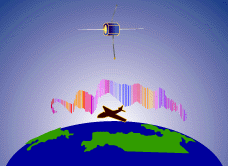About FAST
WHAT HAS FAST DISCOVERED?
The FAST satellite is one of many tools that scientists are using to investigate the aurora and plasma processes occurring in the region where aurora-producing particles are accelerated.
Airborne observatories flying below, sounding rockets passing through, and satellites like FAST orbiting above the auroral zones help give a more complete picture of the complex processes which create the auroral displays.
The visual image of the aurora in the photograph at left was taken with an all-sky camera from a high-altitude airplane observatory. This photograph is aligned with data taken from the FAST satellite.
Superimposed on the visual aurora is a projected path of the FAST satellite which simultaneously collected electron measurements in space when the photograph was taken. The electron data from FAST in the bottom plot shows the number and energies of electrons that are streaming down the Earth's field magnetic field. It is these particles that create the aurora. Notice the peaks in the electron measurement correspond to the visible auroral arcs.
From the data received from FAST, scientists have been able to add to the theory of Auroral Kilometric Radiation (AKR). AKR is a type of radio wave that is emitted by some astronomical objects like pulsars or Jupiter.
It has been known that to some extent, the Earth gives off its own AKR signals. FAST data has helped scientists revise their ideas about how the mechanisms which generate AKR work.
An important outcome of the FAST mission was the verification of a theory. In this theory, it was believed that electron fields are the primary mechanism responsible for accelerating the particles which create the aurora. FAST data provided scientists with the first quantitative measurements which verified this theory.
An unexpected outcome from the FAST mission was the discovery of solitary waves. The space near Earth is filled with plasma particles consisting of electrons and ions. A solitary wave is something like an electron hole or a bubble-like hole of empty space. Electrons are not present in these bubbles.
FAST also showed scientists that these solitary waves move up and down the earth's magnetic field lines and play an important role in maintaining electron fields near the Earth.
Sometimes scientists learn things about phenomena that challenge their theories. These theories then need revision. FAST has caused scientists to do just that when it provided data which showed that the plasma inside the auroral acceleration region was hot, not cold as was expected. This meant that the fundamental models used to describe what happens inside the plasma electron beam need to be revised.
Scientists have known for a long time that there are some regions above the poles where the electrons flow downward through the ionosphere. This region is called the "upward current" region. The electrons in this region are guided to the ionosphere towards the poles with high energy. In the ionosphere, the electrons collide with atoms and molecules creating the visible aurora which we see.
FAST has found that next to these upward current regions are "downward current" regions where electrons move up away from the poles. This region is responsible for the "inverse aurora". Inverse aurora cannot be seen. What is interesting to scientists in this region is its connection to the visible aurora and the fact that positively charged particles are heated there.
